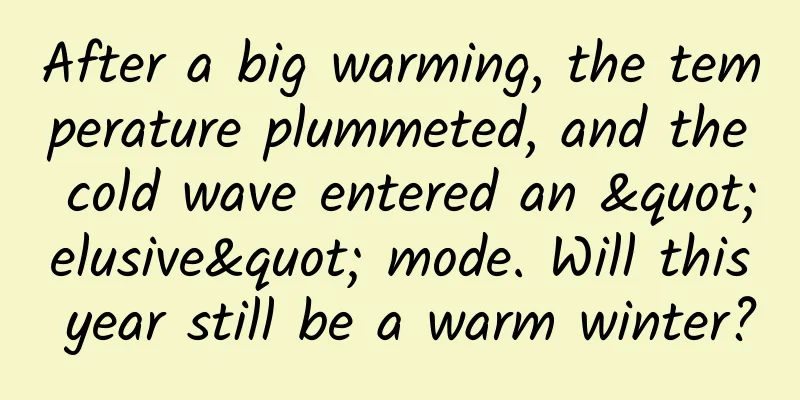After a big warming, the temperature plummeted, and the cold wave entered an "elusive" mode. Will this year still be a warm winter?

|
Recently, heavy snow suddenly hit North China, with the farthest snowfall even reaching Fuyang in Anhui. Social media apps were flooded with reports of heavy snow. When I came back from the south and crossed the North China Plain, I saw that the scenery was almost all covered in snow. This really corresponds to the recent solar term - heavy snow, which usually corresponds to a significant drop in temperature and an increase in precipitation around this day. Copyright images in the gallery. Reprinting and using them may lead to copyright disputes. Entering mid-winter, the sky is cold and the ground is cracked, the days are short and the nights are long, snow and frost are heavy, and all things are closed and hidden. "Light snow covers the land, heavy snow covers the rivers", in the north, when mid-winter comes, the rivers are no longer roaring; in the south, the temperature drops to freezing point, frost begins to appear, and everything is silent. Along with the heavy snow came this winter's old friend - cold air , and the twists and turns in temperature that came with the cold air. The first wave of cooling is coming As the polar vortex moves toward the east of Asia , its center will move south to northern Siberia. Cold air is also gearing up to move southward from Siberia. Two cold air masses will affect our country . The 500hPa high-altitude wind field at 8:00 on December 7 shows that the polar vortex is biased towards the Chinese side of the Eurasian continent. The polar vortex extended to form a large trough and gradually turned vertical . On December 6, under the guidance of the westerly wind in the high-altitude trough, the cold air moved southward and eastward on a large scale , but overall the cooling position was biased to the north, mainly in the northernmost part of the Northeast and northern Xinjiang, bringing large-scale cooling , with local temperatures exceeding 14°C. The cold air also caused gusts of 6 to 9 in most parts of the north on the 7th, bringing dust weather . Cold air mixed with dust is heading southward (Weather situation map at 8:00 on December 6: Central Meteorological Observatory) Although the trough is located to the north and has gradually moved eastward, causing the temperature drop to be concentrated in the north, don't underestimate this cold air. It has brought the sixth round of rain and snow to the Northeast this year , and this snowfall occurred less than a week after the last rain and snow ended. It is a situation of "either snowing or on the way to snowing." The first round of cooling was mainly concentrated in the northernmost part of China (Photo: Central Meteorological Observatory) Frequent rain and snow in Northeast China has caused precipitation to exceed the standard, and the number of snowy days is also significantly higher . According to meteorological data from China Weather Network, the cumulative precipitation in most parts of Northeast China in November this year was more than twice the same period in normal years . The cumulative precipitation in the three provincial capitals of Harbin, Changchun and Shenyang was the highest in the same period since 1951. At the same time, the number of snowy days is also higher than usual. Harbin, Changchun and Shenyang all have more than 10 snowy days in November. Ning'an and Jixian in Heilongjiang even have close to 20 snowy days, which is more than 10 days more than the local annual average. Judging from this trend, it is estimated that frequent heavy snow will continue. The frequent snowfall in Northeast China this year is related to the weather conditions this winter. Snowfall requires sufficient water vapor and rising air currents . The cooperation between the large trough or cold vortex system in the upper air and the cyclone on the ground provides good dynamic conditions for snowfall. On the other hand, the ground cyclone can transport water vapor from the Sea of Japan to Northeast China, providing abundant water vapor conditions . This winter, the overall dynamic and water vapor conditions are good, resulting in frequent snowfall in Northeast China since this winter, with strong intensity and large cumulative snowfall . It can be seen that the cyclone is located on the east side of the northeast. As it rotates, it will draw moisture from the Sea of Japan from north to south to the northeast region, causing snowfall (Photo: Central Meteorological Observatory) But in North China, it is difficult for cold air to bring snowfall to the region. By early December, everyone was still wondering why it hadn’t snowed in Beijing yet. This is related to the prevailing northerly winds in North China in winter, as well as the cold and dry weather . In particular, there are mountains blocking the way in the west and north of Beijing. When the cold air arrives here, the water vapor has basically been released. Only when the warm and humid air flow from the south is sufficient, or when the cold air from the northeast flows back to North China, will it bring snowfall to Beijing. Big recovery followed by big plunge Since the first wave of cold air is weak and moves fast, it will not affect all places for long. After the high-altitude trough passes, the weather will be fine and the temperature will rise quickly . The south is not affected by the cold air, and the temperature will continue to rise in the near future. South: Winter is really hard (Photo: Central Meteorological Observatory) According to data from China Weather Network, as of 16:00 on the 7th, the temperatures at many stations in western Inner Mongolia, Ningxia, Shaanxi, Shanxi, southern Hebei, Henan, northern Shandong, Hubei, and northern Hunan broke the local December maximum temperature records . On the 8th, the 10℃ temperature line will advance to northern Liaoning , and the 20℃ maximum temperature line will push north to the northern Henan-southern Hebei-northern Shandong line. On the 7th, 367 national meteorological stations broke or tied the December maximum temperature record (Photo: China National Meteorological Observatory) A few days ago, many places in the north had the illusion of returning to autumn (Photo: Tianqing-Live) Taiyuan, Wuhan, Hefei, Jinan and Xi'an all broke the December temperature record on the 7th and 8th. For example, the highest temperature in Wuhan on the 8th even reached 24°C. Harbin, Changchun and Shenyang experienced a short-term sharp rise in temperature during the interval between the two cold fronts on the 8th. The highest temperature generally rose above freezing, with a temperature rise of about 10°C. Hefei, Wuhan, Zhengzhou, Taiyuan, weather forecast for the two weeks before and after December 8 (Photo: China Meteorological Administration) As a new round of cold air gathered in Siberia on the 8th and 9th, the temperature took a big dive . Starting from the 9th, the highest temperatures in the central and southern parts of Northeast China, northern and eastern North China, and northern Huanghuai generally dropped by 8~12℃ , with a local drop of more than 15℃; on Sunday, the highest temperatures in southern North China and Huanghuai even dropped by 8~14℃ . At this time, the first wave of cold air has passed, and a new trough is gathering cold air moving southward (Photo: Central Meteorological Observatory) (Photo: Central Meteorological Observatory) The temperature in Northeast China will first experience a big drop , and there will be more obvious snowfall than on the 6th and 7th. The highest temperature in Harbin will drop from 2℃ on the 8th to -17℃ on the 10th, Changchun will drop from 8℃ to -13℃ on the 12th, and Shenyang will drop from 13℃ to -7℃ on the 10th. From the 10th to the 11th, the water vapor conditions will be more abundant, and there will be heavy snowfall in the three northeastern provinces near the Sea of Japan and the Yellow Sea. Weather forecast for Changchun, Harbin and Shenyang for two weeks before and after December 8 (Photo: China Meteorological Administration) In the northern region, snowfall in North China came suddenly. The maximum temperature in Beijing dropped to 1°C on the 10th, the maximum temperature in Shijiazhuang will drop from 22°C to 1°C, and Zhengzhou will drop from 23°C to 2°C. The cumulative drop may reach 21°C. The cold air moving south from the northeast will flow back to North China through the Bohai Sea. Sufficient water vapor conditions will bring snowfall to Beijing-Tianjin-Hebei, northern Shanxi, and northern Shaanxi, and there will be sleet in the central and northern Huanghuai and central and southern Shaanxi. Beijing may see its first snowfall this winter (Photo: China Meteorological Administration) As this strong cold air continues to move southward on the 11th and 12th, the center of temperature drop will continue to move southward , and the maximum temperatures in Jianghuai and Jiangnan will generally drop by 8-14℃. (Photo: Central Meteorological Observatory) The temperature has fluctuated violently in recent days. On the 8th, the overall warming in the country was obvious. After the 9th, various places experienced a roller coaster of temperatures. Coupled with the flu season, everyone should pay attention to keep warm, add clothes in time, and prevent catching a cold. Will this year be a warm winter? In late October this year, the National Climate Center of the China Meteorological Administration released a forecast of climate trends for this winter after research and analysis: it is expected that the temperature in most parts of the country this winter (December 2023 to February 2024) will be close to or slightly higher than the same period in previous years, with the first half of the winter being warmer and the second half of the winter being close to the same period in previous years . In winter, except for the northern part of Northeast China, northeastern Inner Mongolia, western Southwest China, and southern Tibet where the temperature was lower than the same period of previous years, the temperature in most other parts of the country was close to or higher than the same period of previous years. Among them, the temperature in most parts of Liaoning, central Inner Mongolia, Beijing, Tianjin, most parts of Hebei, northern Shandong, and northern Shanxi was 1 to 2℃ higher. The winter temperature has obvious periodic characteristics. The cold air affecting China in the early winter is relatively weak , and the temperature in most parts of the country is higher than the same period of previous years. The cold air activity in the late winter tends to be active , and the temperature in the northern part of Northeast China, eastern Inner Mongolia, western part of Southwest China, Tibet and other places is relatively lower than the same period of previous years. Overall, most of central and eastern China may usher in a warm winter , but the temperature will fluctuate greatly, cold air activities will be more frequent, and the possibility of large-scale extreme cold is low . This may be related to the formation of an El Niño event in the equatorial central and eastern Pacific. The peak period of this El Niño event is expected to be from November 2023 to January 2024, with a peak intensity of between 1.5℃ and 2℃, which is moderate, and will last until the spring of 2024. It can be seen that the equatorial eastern Pacific is significantly warmer, and an El Niño event has already formed (Global SST Anomaly Chart: NOAA). According to research forecasts in November this year (Zheng et al., 2023), the eastern Pacific El Niño phenomenon is about to enter a mature stage , which will trigger abnormal anticyclonic activity in the northwest Pacific region and stimulate teleconnection wave trains within the atmosphere, thereby affecting the winter climate in East Asia and North America. This winter, the El Nino event and the long-term global warming trend are expected to bring about an unusually warm winter in the mid- and low-latitude regions of Eurasia and most of the Americas. There is a 95% chance that the global average surface temperature will hit a record high, and China's surface temperature anomaly may exceed the normal level by more than 2 times, which is expected to set the highest winter temperature record since 1991. The expected extent of warming this winter (Figure: Zheng et al., 2023) Although the sudden snowstorm today makes people feel extremely cold, but from the perspective of the entire large-scale space-time range, this winter is likely to be a warm winter, at least it is already a clear "warm autumn". It should be noted that this warm winter is also different from previous ones. Cold waves come one after another, and the temperature is as high as bungee jumping. The story behind this needs further study. Planning and production Source: Earth Knowledge Bureau (ID: diqiuzhishiju) Author | Xiaozhe Map | Guo Licheng Editor: Wang Mengru |
<<: Can the magical "gene scissors" bring new hope for curing AIDS?
>>: Blizzard is online! Why do we need artificial snow?
Recommend
From a global perspective, here are 4 tips to help you improve product activity
For all our promotions , we must identify the tar...
How to plan a marketing campaign?
Why do businesses conduct marketing activities ? ...
Recommend several useful Linux e-book readers (Part 1)
With the increasing number of handheld devices, p...
3 writing methods for new media operations, highly recommended!
What is the fastest way to become famous? Answer:...
How many people's New Year DNA is touched by a bite of preserved meat? Stroke patients should be more careful about "delicious traps"
As the Year of the Snake approaches, bacon is a p...
Smart eating in winter - why should we pay attention to dark vegetables?
In the past, most of the food we consume is calle...
How to design a suitable TV game?
I first entered the TV game industry half a year ...
5 formulas to analyze the growth secrets of soul APP
As a stranger social product, Soul has establishe...
Haier Air Conditioning's business continues to improve in 2020, with only double growth to make up for shortcomings
After experiencing the double hardships of the pr...
April's "Science" Rumors: Will storing CO2 at sea affect the ecology? Is fat the cause of bloating?
The list of "scientific" rumors for Apr...
If the earth does not wander, where will humans go?
Excerpted from: "Inside and Outside the Clas...
A practical course on color business that goes beyond teaching matching
A practical course on color business that teaches ...
The dishes you must not forget to eat in spring are delicious and nutritious, and very suitable for losing weight and controlling blood sugar!
Asparagus in spring is crisp, tender, sweet and h...
ASO optimization tool is a data-based operation and promotion method!
The Weituo ASO optimization platform has recently...









